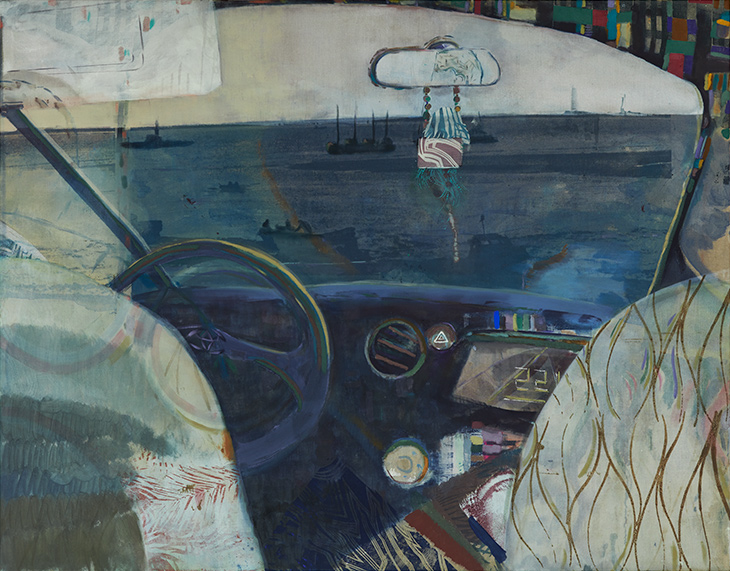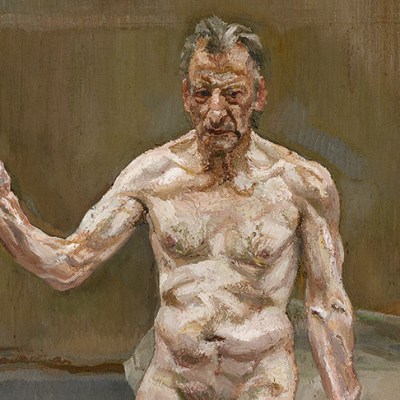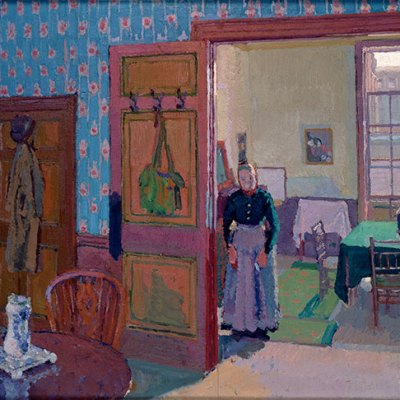Most Londoners would recognise the scene, or a version of it: the scuffed patterns on the train seats and floor, the rows of assorted shoes and clothes, the decisively downturned gaze that keeps all faces out of view. The Commute (2018) as depicted by Nick Goss is as much a state of mind as a particular journey. The large painting, which opens the artist’s exhibition at Pallant House Gallery in Chichester, is a study in listless attention, its linen canvas strewn with the little scraps of everyday life that slide in and out of view over the course of a day.
Commute (2018), Nick Goss. © the artist

This focus on incidental detail characterises many of Goss’s paintings. Date Night (2018), for example, foregrounds a single red chilli nudged to the edge of a finished plate of food. The pepper is peripheral to the evening, one assumes, but you dwell on it here in the same way that you might absent-mindedly at the table when the conversation lapses. In Aftertaste (2018) attention slopes again from the meal at hand to a vase on a side table and a faux-marble floor. These are the sort of scenes you light upon when you’re not really looking, backdrops when you pause for thought. Fixed unexpectedly in paint, they nonetheless retain that sense of distraction and reverie.
In other paintings, Goss lets his thoughts wander well into dream territory, painting fragments of imagery from films, books or personal history into the everyday urban spaces that his art tends to occupy. It is into these canvases that the water seeps. An old-fashioned group of figures struggles to cross a flooded Old Kent Road in King Rooster (2018). Horses wade neck-deep past chicken shops and advertising hoardings in Three Horses (2019). In Lay-by (2019) the viewer looks through the windscreen of an Uber at an inundated landscape (or is it just open sea?) with no road in sight.
King Rooster (2017), Nick Goss. © the artist

Goss has let water shape his art for years, inspired by certain sources – such as images of the devastating North Sea flood of 1953 in Zeeland, where he spent childhood summers, and J.G. Ballard’s The Drowned World (1962), which imagines London submerged – and the general sense that, in his words, ‘even living in the city […] nature could reclaim it at any moment’. Almost every painted mark he makes seems designed to remind the viewer of that risk. He thins his oils down to washes that permeate the canvas or sit lightly over existing layers. The paint drips and bleeds and splashes; in some areas it seems almost to wash clean off, leaving barely a stain. Even Goss’s screen-printed sections, which reproduce found patterns and photographs from De Ramp, a book about the North Sea flood, among other things, have an improvisatory look – of images taking unexpected directions, of marks that threaten to fade no sooner than they are made. In subject and style, these works are infused with a sense of displacement and impermanence.
In a contemporary age troubled by crises of migration and the looming threat of climate change, these works have struck a chord. Goss’s most recent solo exhibitions in London (‘De Ramp’, Josh Lilley Gallery, 2017) and Berlin (‘Dolphin Express’, CFA Berlin, 2018) were critically acclaimed. This is his first museum show, which confers a different sort of weight to his work. Pallant House is renowned for its modern British art, and this exhibition attempts to anchor the painter firmly to that tradition.
Lay-by (2019), Nick Goss. © the artist

Two rooms at the end of the display host works from the musuem’s collection, selected by Goss and presented as his ‘inspirations’ alongside his own sketches and canvases. There are some interesting comparisons to be made. A St Ives painting by Christopher Wood features, unsurprisingly given the centrality of the sea to the Cornish landscape that inspired him. Prunella Clough’s late, abstract canvas Disused Land (1999) complements Goss’s palette and painterly control. In the accompanying wall text, the artist singles out Skylight Landscape (1941) by Paul Nash as an example of restraint – ‘it must have been tempting to drop a patch of crimson into the dark sections of the trees or bring out a highlight here and there’ – shedding interesting light on his own decisions as he teases together his compositions. (Nash’s brand of ‘seaside Surrealism’ and his unsettling Harbour and Room [1932–36] in the Tate are also apt comparisons in terms of subject, though they’re not made here.) Michael Andrews’ large painting of Thames Estuary mud (1994–95) makes an appearance for obvious reasons, sucking the viewer in with its virtuoso depiction of a waterlogged world.
Other comparisons are less obvious. I was somewhat surprised by Goss’s love of the ‘tawdry, meretricious details’ in Edward Burra’s paintings, which are as regularly packed with people as Goss’s are devoid of them. The curators naturally try to draw a link between Goss and Harold Gilman (who is the subject of the other exhibition currently on view at Pallant House), emphasising their interest in urban life and domestic spaces, but it feels slightly tenuous. Nonetheless, seeing the contemporary artist’s works alongside 20th-century examples casts them all in an interesting new light. Goss’s commitment to traditional painting and the flirtation with nostalgia in his imagery have their echoes in the older works, in which ‘contemporary’ themes of displacement and dislocation here swim to the fore.
Morley’s Mirror (2018), Nick Goss. © the artist

In an interview with curator Louise Weller, Goss explained that to exhibit at Pallant House is ‘a bit of a dream. I have been working on this series of paintings non-stop for the last four years and the chance to display them in such a beautiful gallery surrounded by such wonderful works is really something.’ The exhibition’s titular painting Morley’s Mirror (2018), a beautiful image of a mirrored wall in a branch of the South London fast food chain, doubles as a moment of personal reflection for Goss – he has painted patterns from his previous works on to the diamond panes. There’s a sense that, after a frenetic few years, the artist is coming up for air. It will be interesting to see where he goes next.
‘Nick Goss: Morley’s Mirror’ is at Pallant House Gallery, Chichester, until 9 June.



